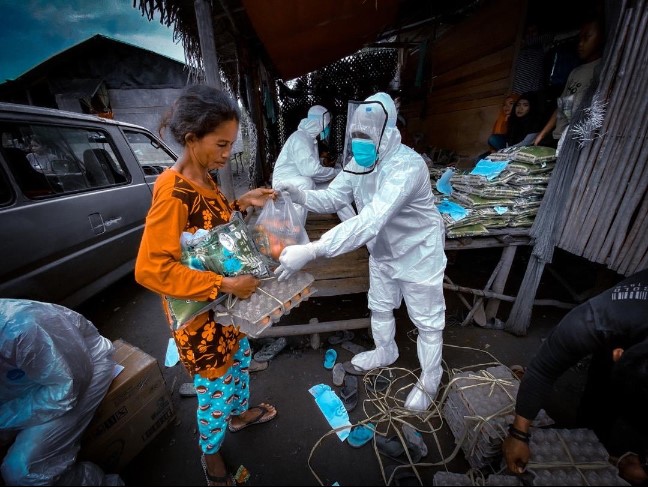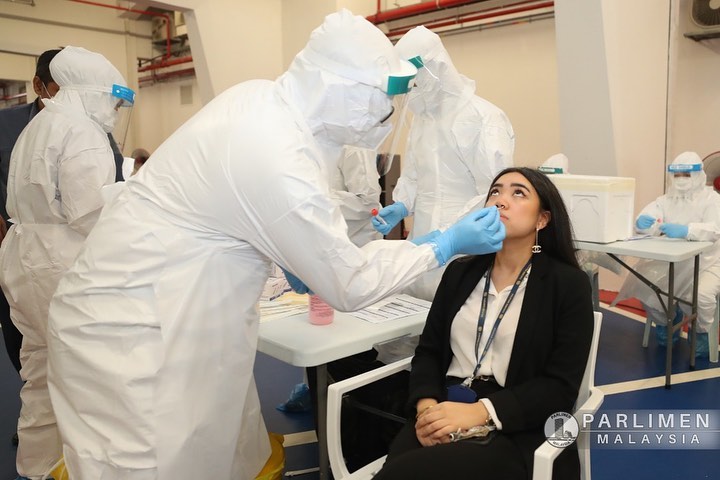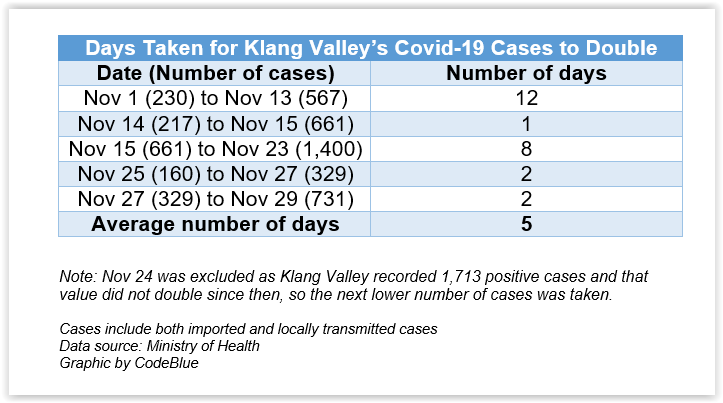KUALA LUMPUR, Dec 9 — Klang Valley’s Covid-19 cases had been doubling at an average of five days in November, despite a lockdown, much faster than the August doubling rate of almost two months.
The rise of Covid-19 cases in Klang Valley, as well as the increase in the doubling rate of the Covid-19 cases, were contributed by clusters sparked by Sabah returnees, shopping mall clusters, and workplace clusters.
Back in August, Klang Valley’s Covid-19 cases took almost two months to double. Selangor, Kuala Lumpur, and Putrajaya had only been reporting single digit cases in August.
From the beginning of October, Covid-19 cases in the Klang Valley then slowly started picking up from 27 cases on October 1 to 161 cases on October 15. On October 14, the government implemented a Conditional Movement Control Order (CMCO) on Klang Valley, which has yet to show any significant improvement in case numbers, as the country’s economic centre has still consistently been reporting three or four-digit cases daily in the whole month of November.
The CMCO implemented in Klang Valley has been extended to December 20, which would make the region’s lockdown more than two months’ long. However, the government has relaxed movement restrictions since December 7, lifting seating caps in private vehicles and seating capacity at restaurant tables, as well as allowing inter-district and interstate movement throughout the country. (Sarawak, however, still maintains a compulsory 14-day quarantine for arrivals from the peninsula and Sabah).
Former Malaysian Medical Association (MMA) president Dr Milton Lum, in his article “Harms of Lockdowns”, cited how Argentina, which has the world’s longest lockdown, failed in terms of controlling Covid-19 cases and whose economy collapsed.
Among Selangor, Putrajaya, and Kuala Lumpur, the highest proportion of Covid-19 cases have been reported in Selangor, followed by Kuala Lumpur, while the tiny administrative centre of Putrajaya has still been maintaining single-digit cases since October.
CodeBlue analysed the time taken for Covid-19 cases to double between October 1 and December 2 to observe the pattern of the rise of Covid-19 cases in the Klang Valley, as compared to Sabah, which was the Covid-19 epicentre in Malaysia, especially in the month of October.
On some days, there will be a drop in the number of cases but following that, a few days later, the cases would double again. Those values were also taken into account in this observation.
On October 1, Klang Valley had 11 positive Covid-19 cases reported. This figure multiplied by 3.7 times within 11 days on October 12 (99 cases). On October 12, there were four new clusters reported in the Klang Valley: Bah Tropicana cluster, Baiduri cluster, Bah Perdana cluster, and Bah Kasturi cluster. All the clusters, except for the Baiduri cluster, had index cases with travel history to Sabah, which by October, was already having a huge Covid-19 outbreak.
After 20 days from October 12, coronavirus cases in Klang Valley doubled to 230 cases on November 1. Most, 97.8 per cent (225 cases) of the total Klang Valley cases reported on November 1, was in Selangor, out of which 172 cases were from the existing clusters.
Following that, in 12 days from November 1 till November 13, Covid-19 cases reported in Klang Valley multiplied by 2.5 times to 567 positive Covid-19 cases.
However, on November 14, the Covid-19 cases reported in Klang Valley dropped to 217 cases, but this figure multiplied within three times on November 15 with 661 positive Covid-19 cases. On November 15, about 71 per cent of the Covid-19 cases in Klang Valley (469) was reported in Kuala Lumpur.
Eight days later, on November 23, Covid-19 cases in Klang Valley doubled to 1,400 positive Covid-19 cases, A total of 1,203 positive Covid-19 cases were reported in Selangor alone, out of which 1,099 cases were from existing clusters.
The next day on November 24, although Covid-19 cases did not double, a record high Covid-19 cases were reported in the Klang Valley (1,713). Most, 94.7 per cent of the cases reported that day (1,623), were from Selangor, mostly from existing clusters (1,539 cases).
On November 25, there was a sharp decline in the number of Covid-19 cases in the Klang Valley, with only 160 cases reported. However, in just two days, this figure doubled to 329 cases on November 27 and then doubled again in two days to 731 cases on November 29. This means that during the last week of November, Covid-19 cases in the Klang Valley took only two days to double.
Although from November 29, Covid-19 cases have yet to double, the new cases reported in the Klang Valley have still been three-digits and in just two months from October 1 till December 1, the Klang Valley has reported a total of 16,373 positive Covid-19 cases.
Klang Valley’s Trend Of Covid-19 Cases Surpasses Sabah
From October 1 till November 13, the Covid-19 cases reported in Sabah were higher than that of Klang Valley. However, since November 17, the daily trend of Covid-19 cases in Klang Valley has been higher than Sabah.
Klang Valley’s coronavirus cases have been showing an increasing trend, while Sabah’s trend of daily Covid-19 cases has remained static since the beginning of October.
On October 1, Sabah reported 118 positive Covid-19 cases, which then took six days to double on October 7 with 282 cases. Eleven days later, the 282 cases reported on October 7 multiplied by 2.5 times to 702 cases on October 18.
Between October 18 to October 21, cases in Sabah showed a declining trend from 702 cases on October 18 to 535 cases on October 21. Following that, the figure multiplied by 2.25 times in 16 days to 1,199 cases on November 6.
Once again, cases started declining in Sabah until November 11, when cases doubled within eight days from 259 cases on November 11 to 660 cases on November 19.
On November 19, Sabah reported 660 positive Covid-19 cases, and since then the number has not doubled. However, the country’s poorest state has still been reporting three-digit cases every day since October.
Sabah Returnees’ Clusters Led To Klang Valley Spike

From the beginning of September, Sabah, which was the epicentre of Malaysia’s Covid-19 epidemic, had started reporting Covid-19 cases continuously every day, and cases were doubling in a very short period of time.
Despite that, Sabah had their state election campaign between September 12 to September 26. During this period of time, many people and politicians travelled in and out of Sabah without having to undergo mandatory Covid-19 screening or 14 days’ quarantine.
Only on September 27, a day after the poll, the government announced that all Sabah returnees will have to undergo mandatory screening for Covid-19, but do not have to undergo mandatory 14 days’ quarantine if they test negative.
However, on September 27 itself, there was already a new cluster identified in Setapak, Kuala Lumpur (Setapak cluster), in which the index case of the cluster had a history of travel to Tawau and Semporna, Sabah. Following that, on September 28, another cluster (Jalan Apas cluster) was identified in Selangor from two Sabah returnees.
On October 20, MOH reported that 30.8 per cent (eight) of the 26 active clusters in Selangor was first detected in individuals who returned from Sabah, while 69.2 per cent (18) of the active clusters were from community infections. This was during the period when cases in the Klang Valley were almost three digits every day.
Shopping Mall Cluster In Klang Valley
On October 10, there was a new cluster reported in Selangor involving the One Utama shopping centre in Petaling Jaya, which was first detected in the index case of a foreigner who works as a security guard in that particular mall.
As of December 2, there are 283 positive Covid-19 cases detected in this cluster, with a positivity rate of 23 per cent. Besides the Klang Valley, this cluster has spread to Melaka.
Klang Valley Has Many Clusters With Positivity Rate Above 25%, 33% Workplace Clusters

As of December 2, Klang Valley had 45 active clusters, among which three had a positivity rate of above 50 per cent, seven clusters between the positivity rate of 30 per cent and 50 per cent, and eight clusters with a positivity rate of between 25 per cent and 30 per cent.
According to Johns Hopkins Bloomberg School of Public Health (JHSPH), a high positivity rate as the World Health Organization (WHO) describes as above 5 per cent means that there’s high coronavirus infection rates.
One way suggested by JHSPH to reduce the positivity rate is by simply testing more people and isolating those infected. JHSPH said when there are not enough people who are being tested in one area, those who do not know that they are infected will be continuously spreading the infection.
Among the 45 active clusters in Klang Valley, 15 were related to workplace clusters which translates to 33.3 per cent of the overall active clusters in Klang Valley. However, all three clusters which have a positivity rate of more than 50 per cent were all workplace related.
Teratai Cluster, Malaysia’s Largest Cluster

On November 7, MOH detected a new cluster (Teratai cluster) involving migrant workers from a rubber glove company, Top Glove Corporation Bhd. The index cases of this cluster were first identified during a symptomatic screening, after which a huge outbreak exploded.
As of December 8, there have been 5,256 positive cases detected in the Teratai cluster. This cluster has a positivity rate of 78.2 per cent so far. On December 2, MOH reported that among the 5,083 positive cases, 93.5 per cent (4,725) of them were foreigners while 6.5 per cent (331) were Malaysians.
On November 17, the government first implemented an enhanced movement control order (EMCO) on the male and female dormitories of Top Glove workers in Klang. Then, on November 23, the government instructed all 28 Top Glove factories in Klang to close after 1,000 of the company’s workers tested positive with Covid-19.
Following that, Human Resource Minister M.Saravanan visited Top Glove’s worker housing and said that it was in a terrible condition. He said that the outbreak could worsen if nothing was done.
In July, the US Customs and Border Protection (CBP) imposed a ban on Top Glove’s products, alleging that the company forces labour, and has abusive working and living conditions.
Despite Top Glove officials claiming that they have been improving the living conditions of their workers since then, the Department of Labour Peninsular Malaysia has opened 19 investigation papers against companies in the Top Glove group covering six of its subsidiaries after enforcement operations was carried out in Top Glove factories in Perak, Kedah, Kelantan, Negeri Sembilan, and Johor.
The company has allegedly failed to comply with the Workers’ Minimum Standard Standard of Housing and Amenities Act 1990 (Act 446). Among the alleged offences include failure to apply for accommodation certification, providing dense workers’ accommodation, and hostels with poor ventilated living conditions.
Living environments as such could only speed up the spread of the coronavirus between their workers.
According to the Khazanah Research Institute in their latest report, “Social Inequalities and Health in Malaysia”, the Singapore government quickly tested all their migrant workers when they had a Covid-19 outbreak among their migrant workers. Furthermore, the Singaporean government also built new dormitories for their migrant workers to reduce congestion in their previous dormitories. However, the Malaysian government said that it will continue its targeted testing method rather than the mass testing method to isolate positive Covid-19 cases.
Initially, this cluster was contained among the workers of Top Glove, but on December 2, Health director-general Dr Noor Hisham Abdullah said that a total of 152 Covid-19 cases were reported at the community level, as there were Malaysian staff who did not stay at the workers’ hostel.
The Selangor state government has now expanded Covid-19 testing to residents around Meru, Klang to identify Covid-19 cases near the Top Glove factory.








